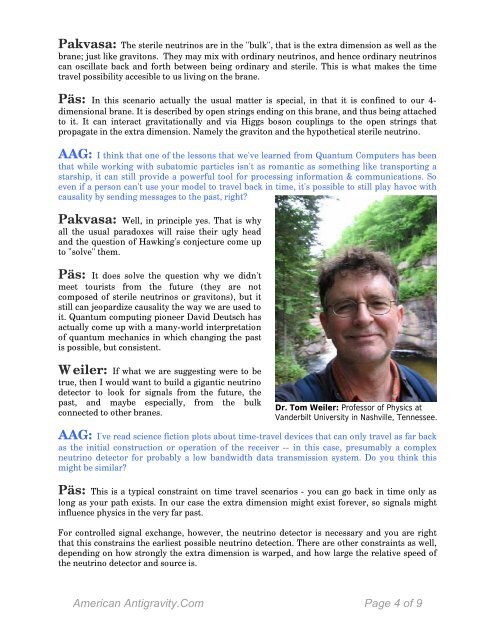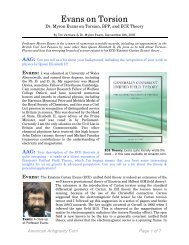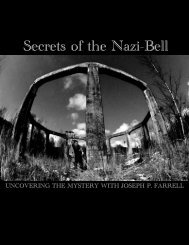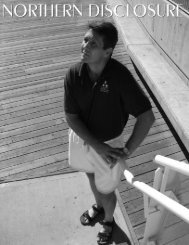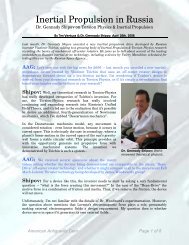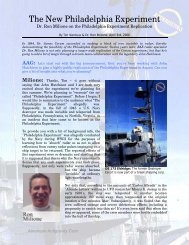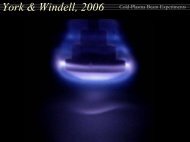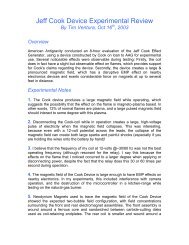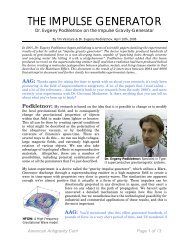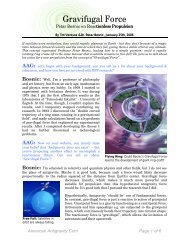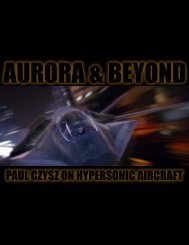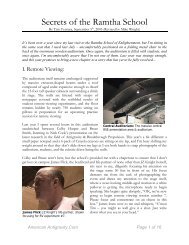Time-Travel-Intervie.. - American Antigravity
Time-Travel-Intervie.. - American Antigravity
Time-Travel-Intervie.. - American Antigravity
Create successful ePaper yourself
Turn your PDF publications into a flip-book with our unique Google optimized e-Paper software.
Pakvasa: The sterile neutrinos are in the "bulk", that is the extra dimension as well as the<br />
brane; just like gravitons. They may mix with ordinary neutrinos, and hence ordinary neutrinos<br />
can oscillate back and forth between being ordinary and sterile. This is what makes the time<br />
travel possibility accesible to us living on the brane.<br />
Päs: In this scenario actually the usual matter is special, in that it is confined to our 4-<br />
dimensional brane. It is described by open strings ending on this brane, and thus being attached<br />
to it. It can interact gravitationally and via Higgs boson couplings to the open strings that<br />
propagate in the extra dimension. Namely the graviton and the hypothetical sterile neutrino.<br />
AAG: I think that one of the lessons that we've learned from Quantum Computers has been<br />
that while working with subatomic particles isn't as romantic as something like transporting a<br />
starship, it can still provide a powerful tool for processing information & communications. So<br />
even if a person can't use your model to travel back in time, it's possible to still play havoc with<br />
causality by sending messages to the past, right?<br />
Pakvasa: Well, in principle yes. That is why<br />
all the usual paradoxes will raise their ugly head<br />
and the question of Hawking's conjecture come up<br />
to "solve" them.<br />
Päs: It does solve the question why we didn't<br />
meet tourists from the future (they are not<br />
composed of sterile neutrinos or gravitons), but it<br />
still can jeopardize causality the way we are used to<br />
it. Quantum computing pioneer David Deutsch has<br />
actually come up with a many-world interpretation<br />
of quantum mechanics in which changing the past<br />
is possible, but consistent.<br />
Weiler: If what we are suggesting were to be<br />
true, then I would want to build a gigantic neutrino<br />
detector to look for signals from the future, the<br />
past, and maybe especially, from the bulk<br />
connected to other branes.<br />
Dr. Tom Weiler: Professor of Physics at<br />
Vanderbilt University in Nashville, Tennessee.<br />
AAG: I've read science fiction plots about time-travel devices that can only travel as far back<br />
as the initial construction or operation of the receiver -- in this case, presumably a complex<br />
neutrino detector for probably a low bandwidth data transmission system. Do you think this<br />
might be similar?<br />
Päs: This is a typical constraint on time travel scenarios - you can go back in time only as<br />
long as your path exists. In our case the extra dimension might exist forever, so signals might<br />
influence physics in the very far past.<br />
For controlled signal exchange, however, the neutrino detector is necessary and you are right<br />
that this constrains the earliest possible neutrino detection. There are other constraints as well,<br />
depending on how strongly the extra dimension is warped, and how large the relative speed of<br />
the neutrino detector and source is.<br />
<strong>American</strong> <strong>Antigravity</strong>.Com Page 4 of 9


